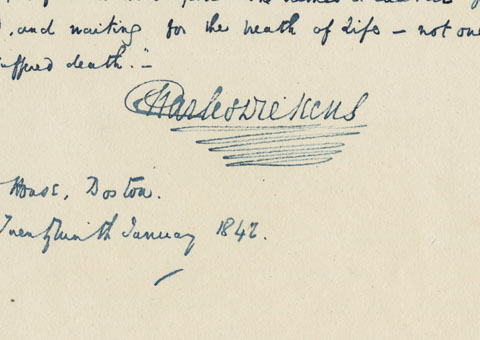In a Rare Letter Mentioning Christmas, Charles Dickens Reflects Wistfully on his Membership in the Shakespeare Club

He arranges to meet with a well known engineer immediately after the holiday
Charles Manby was a well-known British engineers of the mid-19th century, his long career beginning when he assisted his father in building and sailing the world’s first sea-going iron steamboat. Moving spirit of the British Institute of Civil Engineers at the height of the era of invention, he was also Samuel Colt’s...
Charles Manby was a well-known British engineers of the mid-19th century, his long career beginning when he assisted his father in building and sailing the world’s first sea-going iron steamboat. Moving spirit of the British Institute of Civil Engineers at the height of the era of invention, he was also Samuel Colt’s personal choice to oversee the American’s firearms establishment in London – in which capacity, in 1854, he gave a personal tour of Colt’s gun-making factory to his “great friend” Charles Dickens, one of Manby’s many literary acquaintances. Interestingly, while Manby was widely respected for “his intimate knowledge of the most important and gravest paths of the scientific world”, at the same time, he was “associated with the inner circles of the most brilliant theatrical society.”
George Parker Bidder was an English engineer, architect and calculating prodigy. In childhood, his father, William Bidder, a stonemason, exhibited him as the “calculating boy”. In 1837 he was engaged with Robert Stephenson in building the Black-wall railway, and it was he who designed the peculiar method of disconnecting a carriage at each station while the rest of the train went on without stopping, which was employed in the early days of that line when it was worked by means of a cable. He also advised on the construction of the Belgian railways; with Robert Stephenson he made the first railway in Norway, from Christiania to Eidsvold; he was engineer-in-chief of the Danish railways, and he was involved with railways in India. He was also one of the founders of the Electric Telegraph Company, which enabled the public generally to enjoy the benefits of telegraphic communication. In hydraulic engineering, he was the designer of the Victoria Docks.
Dickens loved Christmas stories, and, of course, it is his classic, “A Christmas Carol”, that has contributed so much to his ongoing popularity.
Shakespeare was a great influence on Dickens. As the British library notes: “Charles Dickens’s diary entry for 31 December 1840 records his £1 subscription to the Shakespeare Society. Previously a member of the short-lived Shakespeare Club, from which former members founded the new Society, Dickens was an active member who served as an accounts auditor and member of the Society’s council from 1843-44. The Club and Society were made up of writers, actors, painters and musicians, who met for discussion and readings, as well as to plan and publish new works. At the time of Dickens’s death, his library held 49 of the Society’s publications. For Dickens, Shakespeare was ‘the great master who knew everything’ and the playwright had an undoubted influence on the novelist. Shakespearian quotes and allusions, as well as actors and the stage in general, make frequent appearance throughout Dickens’s writings. Hamlet and Macbeth are predominately referenced, in both the novels and private letters.”
Autograph letter signed, on his Gad’s Hill Place letterhead, Rochester, July 20, 1869, to Manby, mentioning Shakespeare and intimating that they had been in Shakespeare clubs seemingly forever. “Thanks, both for the two interesting addresses, and your interested account of their preparation, all of which I have read with much pleasure. I shall be delighted to meet Mr. Bidder next season in your new house. We propose setting up a temporary caravan in London after Christmas.” PS. “Wasn’t it in 1469 that we belonged with the Shakespeare Club.”

Frame, Display, Preserve
Each frame is custom constructed, using only proper museum archival materials. This includes:The finest frames, tailored to match the document you have chosen. These can period style, antiqued, gilded, wood, etc. Fabric mats, including silk and satin, as well as museum mat board with hand painted bevels. Attachment of the document to the matting to ensure its protection. This "hinging" is done according to archival standards. Protective "glass," or Tru Vue Optium Acrylic glazing, which is shatter resistant, 99% UV protective, and anti-reflective. You benefit from our decades of experience in designing and creating beautiful, compelling, and protective framed historical documents.
Learn more about our Framing Services








































































































